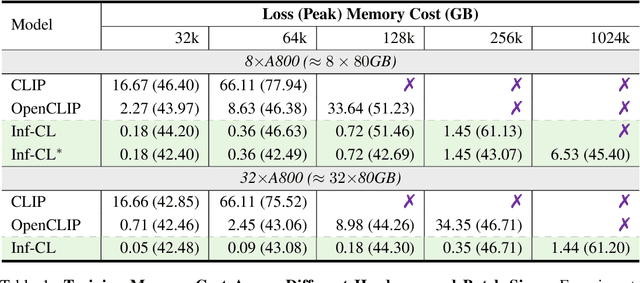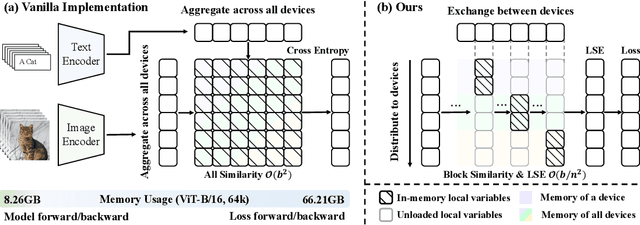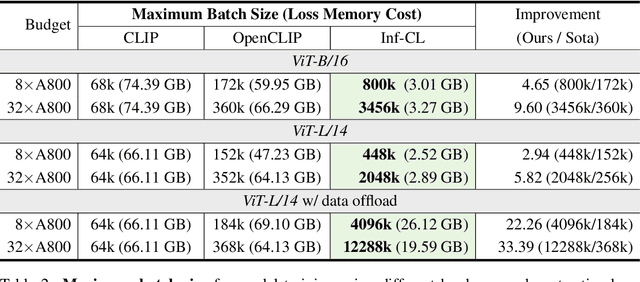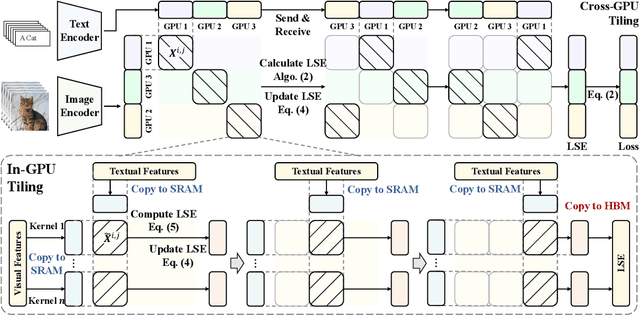Kehan Li
RynnVLA-001: Using Human Demonstrations to Improve Robot Manipulation
Sep 18, 2025Abstract:This paper presents RynnVLA-001, a vision-language-action(VLA) model built upon large-scale video generative pretraining from human demonstrations. We propose a novel two-stage pretraining methodology. The first stage, Ego-Centric Video Generative Pretraining, trains an Image-to-Video model on 12M ego-centric manipulation videos to predict future frames conditioned on an initial frame and a language instruction. The second stage, Human-Centric Trajectory-Aware Modeling, extends this by jointly predicting future keypoint trajectories, thereby effectively bridging visual frame prediction with action prediction. Furthermore, to enhance action representation, we propose ActionVAE, a variational autoencoder that compresses sequences of actions into compact latent embeddings, reducing the complexity of the VLA output space. When finetuned on the same downstream robotics datasets, RynnVLA-001 achieves superior performance over state-of-the-art baselines, demonstrating that the proposed pretraining strategy provides a more effective initialization for VLA models.
LimiX: Unleashing Structured-Data Modeling Capability for Generalist Intelligence
Sep 03, 2025Abstract:We argue that progress toward general intelligence requires complementary foundation models grounded in language, the physical world, and structured data. This report presents LimiX, the first installment of our large structured-data models (LDMs). LimiX treats structured data as a joint distribution over variables and missingness, thus capable of addressing a wide range of tabular tasks through query-based conditional prediction via a single model. LimiX is pretrained using masked joint-distribution modeling with an episodic, context-conditional objective, where the model predicts for query subsets conditioned on dataset-specific contexts, supporting rapid, training-free adaptation at inference. We evaluate LimiX across 10 large structured-data benchmarks with broad regimes of sample size, feature dimensionality, class number, categorical-to-numerical feature ratio, missingness, and sample-to-feature ratios. With a single model and a unified interface, LimiX consistently surpasses strong baselines including gradient-boosting trees, deep tabular networks, recent tabular foundation models, and automated ensembles, as shown in Figure 1 and Figure 2. The superiority holds across a wide range of tasks, such as classification, regression, missing value imputation, and data generation, often by substantial margins, while avoiding task-specific architectures or bespoke training per task. All LimiX models are publicly accessible under Apache 2.0.
RynnEC: Bringing MLLMs into Embodied World
Aug 19, 2025Abstract:We introduce RynnEC, a video multimodal large language model designed for embodied cognition. Built upon a general-purpose vision-language foundation model, RynnEC incorporates a region encoder and a mask decoder, enabling flexible region-level video interaction. Despite its compact architecture, RynnEC achieves state-of-the-art performance in object property understanding, object segmentation, and spatial reasoning. Conceptually, it offers a region-centric video paradigm for the brain of embodied agents, providing fine-grained perception of the physical world and enabling more precise interactions. To mitigate the scarcity of annotated 3D datasets, we propose an egocentric video based pipeline for generating embodied cognition data. Furthermore, we introduce RynnEC-Bench, a region-centered benchmark for evaluating embodied cognitive capabilities. We anticipate that RynnEC will advance the development of general-purpose cognitive cores for embodied agents and facilitate generalization across diverse embodied tasks. The code, model checkpoints, and benchmark are available at: https://github.com/alibaba-damo-academy/RynnEC
FEAT: A Multi-Agent Forensic AI System with Domain-Adapted Large Language Model for Automated Cause-of-Death Analysis
Aug 11, 2025Abstract:Forensic cause-of-death determination faces systemic challenges, including workforce shortages and diagnostic variability, particularly in high-volume systems like China's medicolegal infrastructure. We introduce FEAT (ForEnsic AgenT), a multi-agent AI framework that automates and standardizes death investigations through a domain-adapted large language model. FEAT's application-oriented architecture integrates: (i) a central Planner for task decomposition, (ii) specialized Local Solvers for evidence analysis, (iii) a Memory & Reflection module for iterative refinement, and (iv) a Global Solver for conclusion synthesis. The system employs tool-augmented reasoning, hierarchical retrieval-augmented generation, forensic-tuned LLMs, and human-in-the-loop feedback to ensure legal and medical validity. In evaluations across diverse Chinese case cohorts, FEAT outperformed state-of-the-art AI systems in both long-form autopsy analyses and concise cause-of-death conclusions. It demonstrated robust generalization across six geographic regions and achieved high expert concordance in blinded validations. Senior pathologists validated FEAT's outputs as comparable to those of human experts, with improved detection of subtle evidentiary nuances. To our knowledge, FEAT is the first LLM-based AI agent system dedicated to forensic medicine, offering scalable, consistent death certification while maintaining expert-level rigor. By integrating AI efficiency with human oversight, this work could advance equitable access to reliable medicolegal services while addressing critical capacity constraints in forensic systems.
A Scalable Pipeline for Enabling Non-Verbal Speech Generation and Understanding
Aug 07, 2025Abstract:Human spoken communication involves not only lexical content but also non-verbal vocalizations (NVs) such as laughter, sighs, and coughs, which convey emotions, intentions, and social signals. However, most existing speech systems focus solely on verbal content and lack the ability to understand and generate such non-verbal cues, reducing the emotional intelligence and communicative richness of spoken interfaces. In this work, we introduce $\textbf{NonVerbalSpeech-38K}$, a large and diverse dataset for non-verbal speech generation and understanding, collected from real-world media and annotated using an automatic pipeline. The dataset contains 38,718 samples (about 131 hours) with 10 categories of non-verbal cues, such as laughter, sniff, and throat clearing. We further validate the dataset by fine-tuning state-of-the-art models, including F5-TTS and Qwen2-Audio, demonstrating its effectiveness in non-verbal speech generation and understanding tasks. Our contributions are threefold: (1) We propose a practical pipeline for building natural and diverse non-verbal speech datasets; (2) We release a large-scale dataset to advance research on non-verbal speech generation and understanding; (3) We validate the dataset's effectiveness by demonstrating improvements in both non-verbal speech synthesis and captioning, thereby facilitating richer human-computer interaction.
T2I-ConBench: Text-to-Image Benchmark for Continual Post-training
May 22, 2025Abstract:Continual post-training adapts a single text-to-image diffusion model to learn new tasks without incurring the cost of separate models, but naive post-training causes forgetting of pretrained knowledge and undermines zero-shot compositionality. We observe that the absence of a standardized evaluation protocol hampers related research for continual post-training. To address this, we introduce T2I-ConBench, a unified benchmark for continual post-training of text-to-image models. T2I-ConBench focuses on two practical scenarios, item customization and domain enhancement, and analyzes four dimensions: (1) retention of generality, (2) target-task performance, (3) catastrophic forgetting, and (4) cross-task generalization. It combines automated metrics, human-preference modeling, and vision-language QA for comprehensive assessment. We benchmark ten representative methods across three realistic task sequences and find that no approach excels on all fronts. Even joint "oracle" training does not succeed for every task, and cross-task generalization remains unsolved. We release all datasets, code, and evaluation tools to accelerate research in continual post-training for text-to-image models.
Advances in 4D Generation: A Survey
Mar 19, 2025Abstract:Generative artificial intelligence (AI) has made significant progress across various domains in recent years. Building on the rapid advancements in 2D, video, and 3D content generation fields, 4D generation has emerged as a novel and rapidly evolving research area, attracting growing attention. 4D generation focuses on creating dynamic 3D assets with spatiotemporal consistency based on user input, offering greater creative freedom and richer immersive experiences. This paper presents a comprehensive survey of the 4D generation field, systematically summarizing its core technologies, developmental trajectory, key challenges, and practical applications, while also exploring potential future research directions. The survey begins by introducing various fundamental 4D representation models, followed by a review of 4D generation frameworks built upon these representations and the key technologies that incorporate motion and geometry priors into 4D assets. We summarize five major challenges of 4D generation: consistency, controllability, diversity, efficiency, and fidelity, accompanied by an outline of existing solutions to address these issues. We systematically analyze applications of 4D generation, spanning dynamic object generation, scene generation, digital human synthesis, 4D editing, and autonomous driving. Finally, we provide an in-depth discussion of the obstacles currently hindering the development of the 4D generation. This survey offers a clear and comprehensive overview of 4D generation, aiming to stimulate further exploration and innovation in this rapidly evolving field. Our code is publicly available at: https://github.com/MiaoQiaowei/Awesome-4D.
SegLLM: Multi-round Reasoning Segmentation
Oct 24, 2024



Abstract:We present SegLLM, a novel multi-round interactive reasoning segmentation model that enhances LLM-based segmentation by exploiting conversational memory of both visual and textual outputs. By leveraging a mask-aware multimodal LLM, SegLLM re-integrates previous segmentation results into its input stream, enabling it to reason about complex user intentions and segment objects in relation to previously identified entities, including positional, interactional, and hierarchical relationships, across multiple interactions. This capability allows SegLLM to respond to visual and text queries in a chat-like manner. Evaluated on the newly curated MRSeg benchmark, SegLLM outperforms existing methods in multi-round interactive reasoning segmentation by over 20%. Additionally, we observed that training on multi-round reasoning segmentation data enhances performance on standard single-round referring segmentation and localization tasks, resulting in a 5.5% increase in cIoU for referring expression segmentation and a 4.5% improvement in Acc@0.5 for referring expression localization.
Breaking the Memory Barrier: Near Infinite Batch Size Scaling for Contrastive Loss
Oct 22, 2024



Abstract:Contrastive loss is a powerful approach for representation learning, where larger batch sizes enhance performance by providing more negative samples to better distinguish between similar and dissimilar data. However, scaling batch sizes is constrained by the quadratic growth in GPU memory consumption, primarily due to the full instantiation of the similarity matrix. To address this, we propose a tile-based computation strategy that partitions the contrastive loss calculation into arbitrary small blocks, avoiding full materialization of the similarity matrix. Furthermore, we introduce a multi-level tiling strategy to leverage the hierarchical structure of distributed systems, employing ring-based communication at the GPU level to optimize synchronization and fused kernels at the CUDA core level to reduce I/O overhead. Experimental results show that the proposed method scales batch sizes to unprecedented levels. For instance, it enables contrastive training of a CLIP-ViT-L/14 model with a batch size of 4M or 12M using 8 or 32 A800 80GB without sacrificing any accuracy. Compared to SOTA memory-efficient solutions, it achieves a two-order-of-magnitude reduction in memory while maintaining comparable speed. The code will be made publicly available.
Large-vocabulary forensic pathological analyses via prototypical cross-modal contrastive learning
Jul 20, 2024Abstract:Forensic pathology is critical in determining the cause and manner of death through post-mortem examinations, both macroscopic and microscopic. The field, however, grapples with issues such as outcome variability, laborious processes, and a scarcity of trained professionals. This paper presents SongCi, an innovative visual-language model (VLM) designed specifically for forensic pathology. SongCi utilizes advanced prototypical cross-modal self-supervised contrastive learning to enhance the accuracy, efficiency, and generalizability of forensic analyses. It was pre-trained and evaluated on a comprehensive multi-center dataset, which includes over 16 million high-resolution image patches, 2,228 vision-language pairs of post-mortem whole slide images (WSIs), and corresponding gross key findings, along with 471 distinct diagnostic outcomes. Our findings indicate that SongCi surpasses existing multi-modal AI models in many forensic pathology tasks, performs comparably to experienced forensic pathologists and significantly better than less experienced ones, and provides detailed multi-modal explainability, offering critical assistance in forensic investigations. To the best of our knowledge, SongCi is the first VLM specifically developed for forensic pathological analysis and the first large-vocabulary computational pathology (CPath) model that directly processes gigapixel WSIs in forensic science.
 Add to Chrome
Add to Chrome Add to Firefox
Add to Firefox Add to Edge
Add to Edge